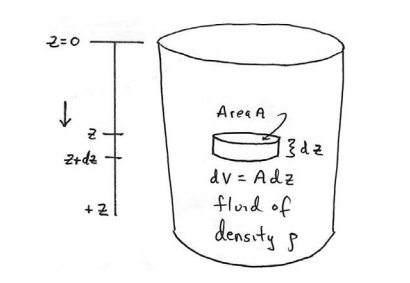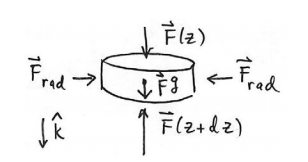27.4: Pascal’s Law - Pressure as a Function of Depth in a Fluid of Uniform Density in a Uniform Gravitational Field
( \newcommand{\kernel}{\mathrm{null}\,}\)
Consider a static fluid of uniform density rho. Choose a coordinate system such that the z - axis points vertical downward and the plane z = 0 is at the surface of the fluid. Choose an infinitesimal cylindrical volume element of the fluid at a depth z , cross-sectional area A and thickness dz as shown in Figure 27.3. The volume of the element is dV=Adz and the mass of the fluid contained within the element is dm=ρAdz.
 Figure 27.2: Coordinate system for fluid
Figure 27.2: Coordinate system for fluidThe surface of the infinitesimal fluid cylindrical element has three faces, two caps and the cylindrical body. Because the fluid is static the force due to the fluid pressure points inward on each of these three faces. The forces on the cylindrical surface add to zero. On the end-cap at z , the force due to pressure of the fluid above the end-cap is downward, →F(z)=F(z)ˆk where F(z) is the magnitude of the force. On the end-cap at z + dz , the force due to the pressure of the fluid below the end-cap is upward,→F(z+dz)=−F(z+dz)ˆk where F(z+dz) is the magnitude of the force. The gravitational force acting on the element is given by →Fg=(dm)gˆk=(ρdV)gˆk=ρAdzgˆk. There are also radial inward forces on the cylindrical body which sum to zero. The free body force diagram on the element is shown in Figure 27.3.

The vector sum of the forces is zero because the fluid is static (Newton’s Second Law). Therefore in the +ˆk F(z)−F(z+dz)+ρAdzg=0
Example 27.1 Pressure in the Earth's Ocean
What is the change in pressure between a depth of 4 km and the surface in Earth’s ocean?
Solution
We begin by assuming the density of water is uniform in the ocean, and so we can use Pascal’s Law, Eq. (27.4.7) to determine the pressure, where we use ρ=1.03×103kg⋅m−3 for the density of seawater (Table 27.1). Then P(z)−P(z=0)=ρgz=(1.03×103kg⋅m−3)(9.8m⋅s−2)(4×103m)=40×106Pa
Example 27.2 Pressure in a Rotating Sample in a Centrifuge
In an ultra centrifuge, a liquid filled chamber is spun with a high angular speed ω about a fixed axis. The density ρ of the fluid is uniform. The open-ended side of the chamber is a distance ro from the fixed axis. The chamber has cross sectional area A and of length L , (Figure 27.4).

The chamber is spinning fast enough to ignore the effect of gravity. Determine the pressure in the fluid as a function of distance r from the fixed axis.
Solution
Choose polar coordinates in the plane of circular motion. Consider a small volume element of the fluid of cross-sectional area A , thickness dr , and mass dM=ρAdr that is located a distance r from the fixed axis. Denote the pressure at one end of the volume element by P(r)=F(r)/A and the pressure at the other end by P(r+dr)=F(r+dr)/A. The free-body force diagram on the volume fluid element is shown in Figure 27.5.

The element is accelerating inward with radial component of the acceleration, ar=−rω2. Newton’s Second Law applied to the fluid element is then (P(r)−P(r+dr))A=−(ρAdr)rω2

